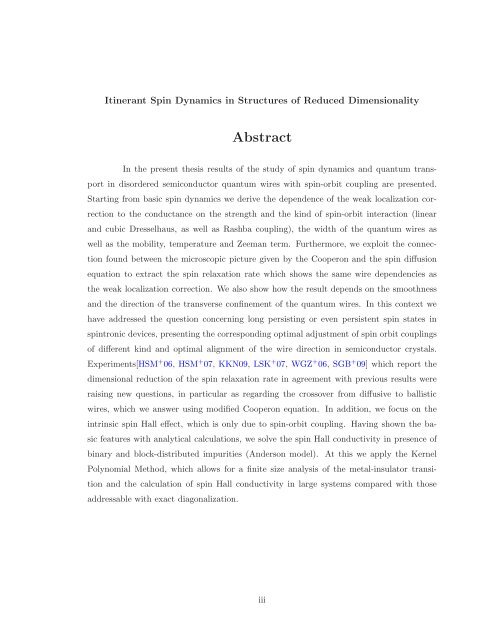Itinerant Spin Dynamics in Structures of ... - Jacobs University
Itinerant Spin Dynamics in Structures of ... - Jacobs University
Itinerant Spin Dynamics in Structures of ... - Jacobs University
You also want an ePaper? Increase the reach of your titles
YUMPU automatically turns print PDFs into web optimized ePapers that Google loves.
<strong>It<strong>in</strong>erant</strong> <strong>Sp<strong>in</strong></strong> <strong>Dynamics</strong> <strong>in</strong> <strong>Structures</strong> <strong>of</strong> Reduced Dimensionality<br />
Abstract<br />
In the present thesis results <strong>of</strong> the study <strong>of</strong> sp<strong>in</strong> dynamics and quantum transport<br />
<strong>in</strong> disordered semiconductor quantum wires with sp<strong>in</strong>-orbit coupl<strong>in</strong>g are presented.<br />
Start<strong>in</strong>g from basic sp<strong>in</strong> dynamics we derive the dependence <strong>of</strong> the weak localization correction<br />
to the conductance on the strength and the k<strong>in</strong>d <strong>of</strong> sp<strong>in</strong>-orbit <strong>in</strong>teraction (l<strong>in</strong>ear<br />
and cubic Dresselhaus, as well as Rashba coupl<strong>in</strong>g), the width <strong>of</strong> the quantum wires as<br />
well as the mobility, temperature and Zeeman term. Furthermore, we exploit the connection<br />
found between the microscopic picture given by the Cooperon and the sp<strong>in</strong> diffusion<br />
equation to extract the sp<strong>in</strong> relaxation rate which shows the same wire dependencies as<br />
the weak localization correction. We also show how the result depends on the smoothness<br />
and the direction <strong>of</strong> the transverse conf<strong>in</strong>ement <strong>of</strong> the quantum wires. In this context we<br />
have addressed the question concern<strong>in</strong>g long persist<strong>in</strong>g or even persistent sp<strong>in</strong> states <strong>in</strong><br />
sp<strong>in</strong>tronic devices, present<strong>in</strong>g the correspond<strong>in</strong>g optimal adjustment <strong>of</strong> sp<strong>in</strong> orbit coupl<strong>in</strong>gs<br />
<strong>of</strong> different k<strong>in</strong>d and optimal alignment <strong>of</strong> the wire direction <strong>in</strong> semiconductor crystals.<br />
Experiments[HSM + 06, HSM + 07, KKN09, LSK + 07, WGZ + 06, SGB + 09] which report the<br />
dimensional reduction <strong>of</strong> the sp<strong>in</strong> relaxation rate <strong>in</strong> agreement with previous results were<br />
rais<strong>in</strong>g new questions, <strong>in</strong> particular as regard<strong>in</strong>g the crossover from diffusive to ballistic<br />
wires, which we answer us<strong>in</strong>g modified Cooperon equation. In addition, we focus on the<br />
<strong>in</strong>tr<strong>in</strong>sic sp<strong>in</strong> Hall effect, which is only due to sp<strong>in</strong>-orbit coupl<strong>in</strong>g. Hav<strong>in</strong>g shown the basic<br />
features with analytical calculations, we solve the sp<strong>in</strong> Hall conductivity <strong>in</strong> presence <strong>of</strong><br />
b<strong>in</strong>ary and block-distributed impurities (Anderson model). At this we apply the Kernel<br />
Polynomial Method, which allows for a f<strong>in</strong>ite size analysis <strong>of</strong> the metal-<strong>in</strong>sulator transition<br />
and the calculation <strong>of</strong> sp<strong>in</strong> Hall conductivity <strong>in</strong> large systems compared with those<br />
addressable with exact diagonalization.<br />
iii
















